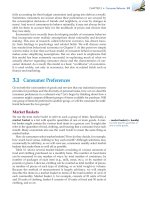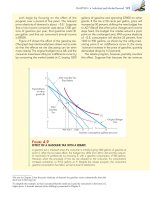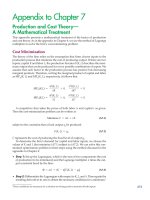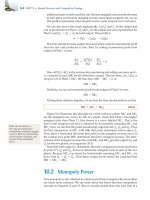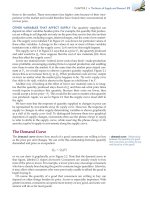(8th edition) (the pearson series in economics) robert pindyck, daniel rubinfeld microecon 268
Bạn đang xem bản rút gọn của tài liệu. Xem và tải ngay bản đầy đủ của tài liệu tại đây (80.57 KB, 1 trang )
CHAPTER 7 • The Cost of Production 243
7.3 Cost in the Long Run
In the long run, a firm has much more flexibility. It can expand its capacity by
expanding existing factories or building new ones; it can expand or contract its
labor force, and in some cases, it can change the design of its products or introduce new products. In this section, we show how a firm can choose its combination of inputs to minimize its cost of producing a given output. We will also
examine the relationship between long-run cost and the level of output. We begin
by taking a careful look at the cost of using capital equipment. We then show
how this cost, along with the cost of labor, enters into the production decision.
The User Cost of Capital
Firms often rent or lease equipment, buildings, and other capital used in the
production process. On other occasions, the capital is purchased. In our analysis, however, it will be useful to treat capital as though it were rented even if it
was purchased. An illustration will help to explain how and why we do this.
Let’s suppose that Delta Airlines is thinking about purchasing a new Boeing 777
airplane for $150 million. Even though Delta would pay a large sum for the airplane now, for economic purposes the purchase price can be allocated or amortized across the life of the airplane. This will allow Delta to compare its revenues
and costs on an annual flow basis. We will assume that the life of the airplane is 30
years; the amortized cost is therefore $5 million per year. The $5 million can be
viewed as the annual economic depreciation for the airplane.
So far, we have ignored the fact that had the firm not purchased the airplane,
it could have earned interest on its $150 million. This forgone interest is an
opportunity cost that must be accounted for. Therefore, the user cost of capital—
the annual cost of owning and using the airplane instead of selling it or never
buying it in the first place—is given by the sum of the economic depreciation and
the interest (i.e., the financial return) that could have been earned had the money been
invested elsewhere.6 Formally,
User Cost of Capital = Economic Depreciation + (Interest Rate)
(Value of Capital)
In our example, economic depreciation on the airplane is $5 million per year.
Suppose Delta could have earned a return of 10 percent had it invested its
money elsewhere. In that case, the user cost of capital is $5 million + (.10)
($150 million − depreciation). As the plane depreciates over time, its value
declines, as does the opportunity cost of the financial capital that is invested in
it. For example, at the time of purchase, looking forward for the first year, the
user cost of capital is $5 million + (.10)($150 million) = $20 million. In the tenth
year of ownership, the airplane, which will have depreciated by $50 million,
will be worth $100 million. At that point, the user cost of capital will be
$5 million + (.10)($100 million) = $15 million per year.
We can also express the user cost of capital as a rate per dollar of capital:
r = Depreciation rate + Interest rate
6
More precisely, the financial return should reflect an investment with similar risk. The interest rate,
therefore, should include a risk premium. We discuss this point in Chapter 15. Note also that the
user cost of capital is not adjusted for taxes; when taxes are taken into account, revenues and costs
should be measured on an after-tax basis.
• user cost of capital Annual
cost of owning and using a
capital asset, equal to economic
depreciation plus forgone
interest.

